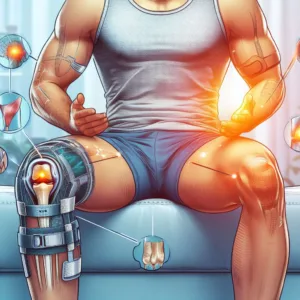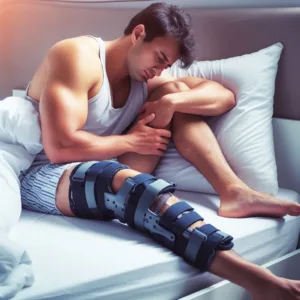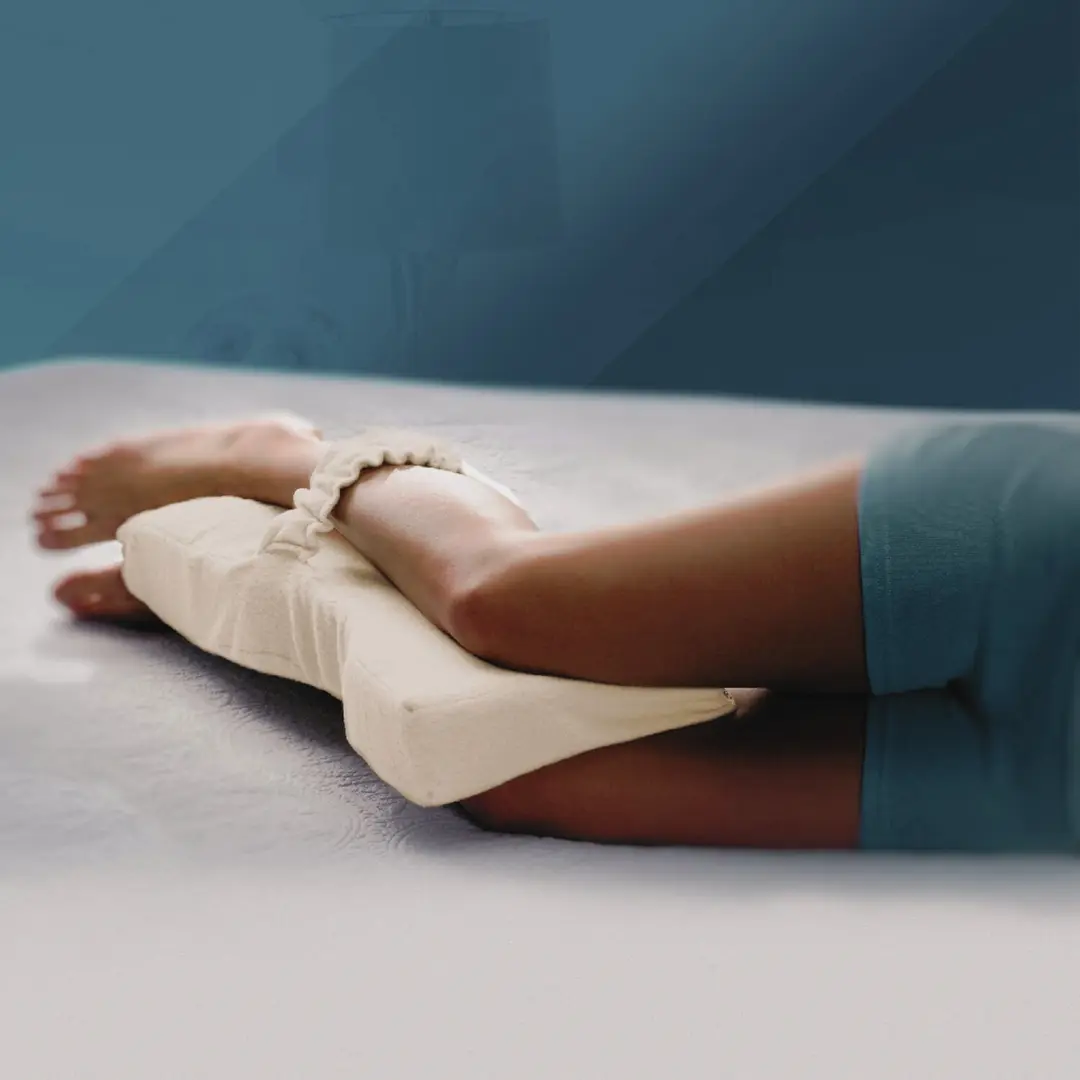
Have you ever struggled to find a sleeping position that is comfortable while using a knee brace? or Can you sleep with a knee brace. You’re not alone in this problem, I assure you. We’ll get right to it: Is it safe to wear a knee brace while you sleep? Be prepared for a thorough analysis of the advantages and disadvantages as well as professional guidance to help you finally get the restful night’s sleep you’ve been searching for. So settle back, unwind, and get ready to discover everything there is to know about sleeping with a knee brace!
Contents
- 0.1 Why People Wear Knee Braces in the First Place
- 0.2 To Sleep or Not to Sleep with a Knee Brace
- 0.3 Pros of Sleeping with a Knee Brace
- 0.4 Cons of Sleeping with a Knee Brace
- 0.5 Types of Knee Braces and Their Impact on Sleep
- 0.6 Tips for Sleeping Comfortably with a Knee Brace
- 0.7 Alternatives to Wearing a Knee Brace to Bed
- 1 FAQs:
Why People Wear Knee Braces in the First Place

Injury recovery
Sleeping with a knee brace on can significantly aid in injury recovery. It keeps the joint properly aligned, reducing pain and promoting healing overnight. It also provides stability and support, preventing unnecessary movement or strain. Sleeping with a knee brace also helps alleviate morning stiffness, as muscles and joints tend to stiffen during sleep. Gentle compression promotes blood flow and reduces swelling, reducing morning stiffness and allowing for better mobility. So, try sleeping with a knee brace to witness its positive impact on injury recovery.
Arthritis relief
Pain and stiffness in joints can hinder sleep for arthritis patients. Knee braces designed for arthritis provide support and compression, reducing pain and inflammation. They stabilize the knee joint, improving mobility during daily activities. Overnight knee brace use can increase support and lessen joint pain from pressure or improper alignment. Consult a healthcare professional for personalized recommendations based on your needs and condition.
Sports protection
Knee braces are essential for athletes recovering from injuries and undergoing rehabilitation. They provide stability and support, allowing joint healing and minimizing pain. However, each individual’s injury is unique, so consulting a medical professional is crucial. The type of knee brace used should be chosen based on comfort and the individual’s unique needs. Some braces are designed for overnight use, while others are rigid or heavy-duty, affecting sleep comfort. Choosing the right type of knee brace is crucial for optimal healing and injury prevention.
Knee Injuries from Tennis: Best Treatment for Tennis Knee Injury
General knee support
Knee braces are essential for managing pain and enhancing stability. They wrap around the knee joint, providing compression and support. The hinged knee brace offers a better range of motion and prevents excessive movement, while the compression sleeve or wrap provides constant pressure. These supports are suitable for physical activities and everyday tasks. Consult a healthcare professional to determine the best option for your specific needs and experience the benefits of knee support.
To Sleep or Not to Sleep with a Knee Brace
The decision to sleep with a knee brace can be a tough one. On one hand, you may need extra support and stability during the night, especially if you’re recovering from a knee injury or surgery. On the other hand, wearing a knee brace while sleeping can be uncomfortable and restrictive, making it difficult to get a good night’s rest.
One important factor to consider is the type of knee brace you are using. Some braces have adjustable straps and hinges that allow for flexibility and movement, making sleeping with them more manageable. However, others may be bulkier and more rigid, limiting your ability to find a comfortable sleeping position.
Common myths debunked
Myth #1: Wearing a knee brace at night can restrict blood circulation and lead to serious health issues. This is not true! While it is important to choose the right type of knee brace that allows for proper blood flow, wearing a knee brace during sleep can provide support and relieve pain. Many healthcare professionals recommend sleeping with a knee brace for recovering from injuries or managing chronic conditions like arthritis.
Myth #2: Sleeping with a knee brace will weaken your leg muscles over time. Contrary to popular belief, using a knee brace during sleep does not automatically result in muscle atrophy. While it is true that excessive reliance on a knee brace without engaging in proper rehabilitation exercises may lead to muscle weakness, using the brace as part of an overall treatment plan can help speed up recovery and enhance muscle strength. The key lies in striking the right balance between utilizing the benefits of the knee brace and incorporating appropriate exercise routines into your daily routine.
Pros of Sleeping with a Knee Brace
Pain relief
Finding effective pain relief is one of the most important considerations when wearing a knee brace. After all, if you can’t sleep comfortably with the brace on, what’s the point? Luckily, there are various options available that can provide much-needed pain relief. Over-the-counter pain medications like ibuprofen or acetaminophen are easily accessible and can help alleviate mild to moderate discomfort. However, you must consult your doctor before taking any medication, especially if you have existing medical conditions or other medications.
Better knee alignment
Better knee alignment is essential for overall knee health and preventing injuries. When your knees are properly aligned, the stress and pressure on the joints are evenly distributed, reducing the risk of strain and pain. One way to improve knee alignment is through exercise and strengthening certain muscle groups. The muscles surrounding the knees, such as the quadriceps and hamstrings, support proper alignment. Incorporating exercises targeting these muscle groups into your fitness routine can enhance stability and promote better knee alignment.
Faster recovery
One of the key factors in a faster recovery is optimal sleep. Getting a good night’s rest can be challenging when you’re injured and wearing a knee brace. However, studies have shown that quality sleep is crucial to our body’s healing process. Wearing a knee brace to bed provides your injured knee with the necessary stability and support, allowing you to get into more comfortable positions that promote better sleep.
In addition to using a knee brace for sleeping, there are other habits you can adopt to enhance recovery time. Light exercises or physical therapy before bed can help reduce swelling and stiffness in your knees while improving blood circulation.
Cons of Sleeping with a Knee Brace
Discomfort and skin irritation

Restricted blood flow
Restricted blood flow is a common concern when using a knee brace, and rightfully so. The compression provided by the brace can constrict blood vessels and limit circulation to the affected area. While this may sound alarming, it’s important to understand that not all knee braces are created equal. Some models have been specifically designed with features to mitigate the risk of restricted blood flow.
Potential for worsening condition
While a knee brace can provide much-needed support and stability, it’s important to consider the potential for a worsening condition if used incorrectly or for extended periods. Although wearing a knee brace while sleeping may provide temporary relief, relying on it as a long-term solution can lead to muscle weakness and dependency on the brace. This is because the muscles around the knee become accustomed to the brace’s external support, which can decrease strength and flexibility over time.
Types of Knee Braces and Their Impact on Sleep
Compression sleeves

One of the benefits of wearing a compression sleeve while sleeping is that it provides gentle and consistent pressure throughout the night. This constant compression stimulates blood flow to the injured knee, facilitating tissue repair and reducing inflammation. Additionally, the snug fit of these sleeves offers stability to the joint, preventing excessive movement that could cause further discomfort overnight.
Hinged knee braces
Hinged knee braces have become popular for those seeking support and comfort. Unlike traditional knee braces, hinged options provide additional stability by restricting certain movements while allowing the necessary range of motion. This is especially beneficial for individuals recovering from injury or surgery, as it aids in healing and prevents further damage. Additionally, hinged knee braces are designed to be worn comfortably throughout the day and even during sleep, providing continuous support when needed most.
Wraparound braces
Wraparound braces are popular for those seeking comfort and support while sleeping with a knee brace on. Unlike traditional knee braces that often feature straps or Velcro closures, wraparound braces offer a unique design that allows easy application and adjustment. These braces typically feature adjustable straps or elastic bands around the knee to provide a secure fit. Their versatile design not only ensures optimal compression and stability throughout the night but also makes them suitable for use during everyday activities.
Patellar straps
Patellar straps, also known as knee straps or patella bands, have gained popularity in recent years for their ability to alleviate pain and discomfort associated with conditions like runner’s knee and patellofemoral pain syndrome. These adjustable bands are designed to be worn just below the kneecap, exerting gentle pressure on the patellar tendon and stabilizing the knee joint during physical activities.
But can you sleep with a patellar strap on?
The answer depends on personal preference and comfort levels. Some individuals find that wearing a patellar strap while sleeping provides additional support and reduces morning stiffness in the knee. The slight compression offered by the strap helps keep the knee aligned properly throughout the night, reducing any potential discomfort upon waking up.
Suppose you decide to experiment with wearing a patellar strap overnight. In that case, choosing a well-fitting and comfortable strap that provides adequate support without causing discomfort or restricting blood flow is essential.
Tips for Sleeping Comfortably with a Knee Brace
Adjust the straps
Adjusting the straps of your knee brace might seem like a minor detail, but it can make a world of difference when it comes to getting a good night’s sleep. Properly adjusting the straps ensures the brace stays securely in place while you toss and turn throughout the night. It also helps to alleviate any discomfort or irritation caused by an ill-fitting brace.
In addition to adjusting the tightness, pay close attention to how you position and fasten each strap. Ensure they are evenly distributed around your knee and avoid twisting or bunching of fabric. This will help maintain stability while you move during sleep.
Use pillows for support.
Using pillows for support when sleeping with a knee brace can make all the difference in getting a good night’s rest. Not only do pillows provide added cushioning and comfort, but they also help to align your body and reduce any strain on your knee.
Test different sleep positions.
Did you know that your sleep position can affect the quality of your sleep? It’s true! Different sleep positions can affect our body and our overall comfort during the night. If you’re wondering if you can sleep with a knee brace, consider experimenting with various sleeping positions to find the best option.
One common sleep position is sleeping on your back. Doctors often recommend this position as it aligns the spine and reduces the risk of developing wrinkles caused by pillow friction. However, wearing a knee brace may offer more comfortable options than this position. Sleeping on your back could put pressure on your knee, leading to discomfort throughout the night.
An alternative sleep position worth trying is sleeping on your side. This engages different muscles and joints, distributing weight more evenly across the body. When wearing a knee brace, this position can help alleviate pressure from the affected area and allow for better circulation. Experiment with different variations of side sleeping, such as holding a pillow between your knees or placing one beneath them, to find what feels most supportive for your injured knee and overall comfort level.
Alternatives to Wearing a Knee Brace to Bed
Knee pillows

Click to See the price of Knee Pillow on Amazon
One of the key benefits of using a knee pillow is its ability to alleviate the pain and stiffness associated with wearing a knee brace. By elevating your leg slightly with the help of a knee pillow, you can relieve muscle tension and reduce swelling around the affected area. Not only does this enhance circulation to facilitate healing, but it also helps improve mobility during sleep and minimize post-sleep stiffness upon waking up.
Elevation techniques
One effective technique to elevate your leg while sleeping with a knee brace on is using pillows. However, it’s more complex than just throwing a couple of cushions under your leg. It would help if you strategically positioned the pillows to achieve proper elevation for maximum benefit. Start by placing a pillow or rolled-up blanket beneath your calf and ankle, allowing your lower leg to rest comfortably. Then, add another pillow under your knee joint, ensuring it is slightly bent. This alignment helps reduce pressure on the knee and promotes better blood circulation during sleep.
Another elevation technique that can work wonders for sleeping with a knee brace involves using an adjustable bed or mattress foundation. These products allow you to customize the elevation angle according to your preferences and comfort level. Raising the head section slightly allows you to create an incline that takes the pressure off your knee joint while maintaining proper alignment with the rest of your body. Plus, with adjustable beds becoming more affordable and readily available in recent years, this option is now accessible to more people than ever before.
Heat or cold therapy
Heat and cold therapy are often recommended as effective relief methods when dealing with knee pain and discomfort. But which one is better? It depends on the nature of your injury or condition. Heat therapy is great for soothing stiff muscles and increasing blood flow to the affected area. It can help relax tense muscles and promote healing by delivering more oxygen and nutrients to the tissues. On the other hand, cold therapy is best for reducing inflammation and numbing pain. Applying ice or a cold pack can constrict blood vessels in the area, reducing swelling and providing temporary relief.
FAQs:
Should you wear a compression sleeve to bed?
Wearing a compression sleeve to bed has become popular for those suffering from knee pain or injuries. While some experts argue in favor of wearing the sleeve overnight to provide continuous support and reduce swelling, others caution against it. One important consideration is the tightness of the compression sleeve. Wearing an excessively tight sleeve can restrict blood flow during sleep, leading to discomfort and even potential damage to the tissues. It is crucial to find a balance between adequate support and allowing sufficient circulation during rest.
Can you sleep with leg compression sleeves?
When it comes to leg compression sleeves, many people wonder if it’s safe and comfortable to sleep with them on. The short answer is yes, you can sleep with leg compression sleeves, and there are several benefits to doing so. Leg compression sleeves are designed to improve blood circulation and reduce swelling in the legs, which can be particularly helpful for people who suffer from conditions such as varicose veins or edema. Wearing leg compression sleeves while you sleep can help alleviate discomfort and promote faster recovery.
Is it okay to wear knee support while sleeping?
Wearing knee support while sleeping can relieve those suffering from knee pain or injuries, but is it okay? The answer is it depends. While some medical experts claim that wearing a knee brace at night can help stabilize the joint and reduce discomfort, others argue that it may contribute to muscle weakness and even hinder healing.
Conclusion: Can You Sleep with a Knee Brace On?
In conclusion, sleeping with a knee brace is possible and beneficial for those dealing with knee injuries or chronic pain. By following the tips and techniques outlined in this ultimate guide, you can ensure a comfortable and restful night’s sleep while supporting your injured knee. Remember to choose the right type of brace, adjust it properly for optimal comfort, and use additional aids like pillows or mattress toppers as needed. Don’t let your knee pain keep you awake any longer. Give sleeping with a knee brace a try tonight and experience the difference it can make in your overall well-being. Sweet dreams!




